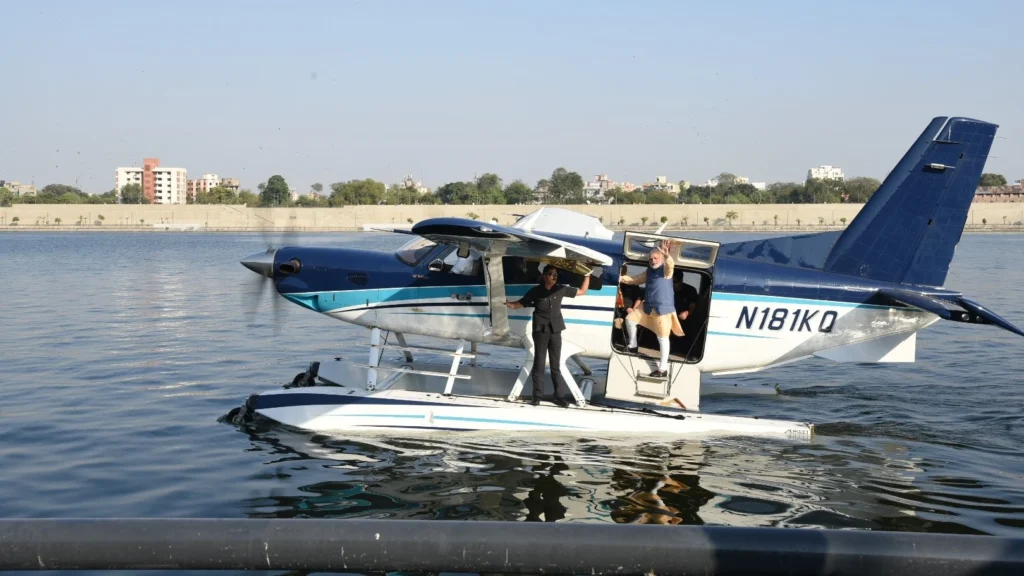GURUGRAM- Ajay Singh-led SpiceJet (SG) plans to officially launch seaplane services in 2025, on multiple routes nearly four years after its first seaplane route trial.
On Saturday (November 10, 2024), the low-cost carrier conducted a demonstration flight from Prakasam Barrage in Vijayawada to the temple town of Srisailam Dam in Andhra Pradesh.

SpiceJet Seaplanes Routes
SpiceJet stated that it has been actively involved in seaplane trials across multiple locations, working closely with De Havilland to provide essential engineering, technical, and logistical support.
The project is headed by Avani Singh, the CEO of Spice Shuttle and daughter of SpiceJet’s CMD, Ajay Singh. She expressed optimism about the potential of seaplanes, noting that they could “transform connectivity” in India, where varied geographies and infrastructure challenges exist across coastlines, islands, and riverine regions.

SpiceJet holds rights to operate seaplane services on 20 routes, including Lakshadweep, Hyderabad, Guwahati, and Shillong. The budget airline plans to expand connectivity on these routes as soon as the necessary infrastructure is established.
Ajay Singh, SpiceJet’s Chairman and Managing Director, stated, “Seaplanes can transform regional connectivity in India, giving access to remote and scenic parts of the country. We are taking concrete steps to make seaplane operations a reality in India again.”
The trial event was attended by Andhra Pradesh Chief Minister N. Chandrababu Naidu and Union Civil Aviation Minister Kinjarapu Rammohan Naidu.
SpiceJet launched India’s first scheduled seaplane service in October 2020, connecting Ahmedabad’s Sabarmati Riverfront to the Statue of Unity in Kevadia, Gujarat. Services were paused due to COVID-19.
SpiceJet is also expanding its domestic network with eight new flights launching on November 15, connecting Jaipur to Varanasi, Amritsar, and Ahmedabad, and linking Ahmedabad with Pune. This expansion aims to strengthen regional connectivity across India.
However, SpiceJet faces financial challenges. Recent Directorate General of Civil Aviation (DGCA) data shows the airline’s domestic market share declined to 2.3% in August 2025, a significant drop from 7.3% in January the previous year.
Additionally, SpiceJet reported a 19.65% decrease in consolidated profits for Q1 FY25, with profits falling to Rs 158.75 crore from Rs 197.58 crore in the same quarter last year.

How it Started?
Seaplanes have been part of commercial aviation since the early 20th century, with the first seaplane flight in 1910 followed by the luxurious Pan Am Clippers in the 1930s and 40s. Today, seaplanes are generally small aircraft used to connect remote regions.
It is rare for mainstream airlines to enter seaplane operations, making SpiceJet’s venture into this market notable, especially since the move came during the COVID-19 pandemic, a period when most airlines were reducing services.
SpiceJet was not new to seaplane projects, having conducted trials across India since 2017. The airline’s commercial seaplane plans advanced when it secured 18 routes under the Indian government’s UDAN scheme, aimed at connecting underserved regional airports.
SpiceJet launched its first seaplane service in October 2020, linking Ahmedabad, India’s seventh-busiest airport, with Kevadia, the site of the world’s tallest statue, the Statue of Unity dedicated to Sardar Vallabhbhai Patel.
SpiceJet Chairman and Managing Director Ajay Singh highlighted the importance of seaplanes in India, stating, “With the ability to land on small water bodies, seaplanes are ideal for connecting remote areas to the aviation network without the need for expensive infrastructure like airports and runways.”

The service was inaugurated by Prime Minister Narendra Modi, who took the 50-minute inaugural flight from Kevadia to Ahmedabad’s Sabarmati Riverfront. However, challenges emerged from the start. Reports indicated that SpiceJet and its partners lacked essential environmental clearances, particularly for water aerodrome construction in both cities.
The seaplane used for the service, a 15-seat de Havilland Twin Otter 300 leased from Maldivian, faced additional issues. The 52-year-old aircraft needed frequent maintenance, which led to frequent service suspensions. On two occasions, the plane had to return to the Maldives for lengthy repairs, resulting in disrupted operations.

Failure Despite Government Support
By April 2021, SpiceJet decided to suspend the seaplane service due to operational difficulties. Over six months, the airline operated only 276 flights, transporting a total of 2,192 passengers.
The Gujarat state government later confirmed that the service was discontinued because of high operational costs, despite investments exceeding $2 million in water aerodrome infrastructure.
India possesses several key factors favorable for regional seaplane services:
- Expanding Aviation Market: India ranks as the third-largest and fastest-growing aviation market globally.
- Government Backing: The UDAN program is actively investing in regional aviation to improve access to underserved areas.
- Growing Tourism Industry: India’s tourism sector, currently valued at $24 billion, is set to expand by 9.6% annually over the next four years.
- Supportive Geography: India’s extensive coastlines, abundant waterways, and numerous islands provide ideal conditions for seaplane operations similar to those of Trans Maldivian Airways, Kenmore Air in Seattle, and Harbor Air in Canada.
Recognizing these advantages, the Gujarat government issued a tender in late 2021 to replace the suspended SpiceJet service. By February 2022, Maritime Energy Heli Air Services (MEHAIR) won the bid to resume seaplane operations on the Ahmedabad-Kevadia route.
Initially, MEHAIR seemed like the ideal, well-funded choice to revive seaplane services, with the necessary experience to succeed. However, despite plans, no service was launched in 2022.
By May 2023, a new tender was issued for the route, indicating that earlier efforts had stalled. As of January 2024, the Gujarat government confirmed that no bidders had come forward for the service.
Will the Seaplane service soar high in India or it will stay on the ground? Let us know your thoughts on our social media posts.
Stay tuned with us. Further, follow us on social media for the latest updates.
Join us on Telegram Group for the Latest Aviation Updates. Subsequently, follow us on Google News

